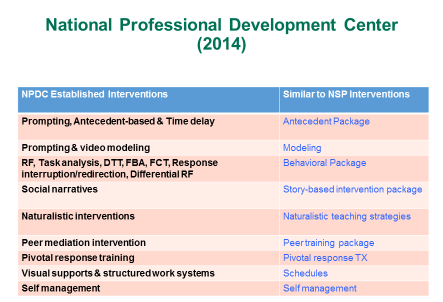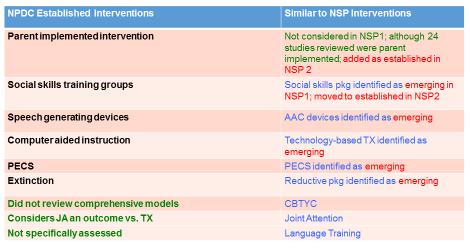Introduction
It's quite an honor to present in honor of Nancy McKinley, who I knew very well. In this course, we're going to talk about recent research in autism spectrum disorders and provide some things to think about as you're making decisions regarding intervention for the students that you serve.
I am going to focus on parent implemented interventions because there is some new research coming out that's very exciting and is important for speech language pathologists and others to be aware of. I like to use a universal design framework so that you know what you're going to learn, how you're going to learn it, and why it's important. It's important to look at the current research on evidence-based interventions, and then focus on some parent training for children with autism that seems to have a growing evidence base. Some of the early work is actually showing some neurological changes at the level of brain functioning for children. It’s also important to understand how parents fit in to the intervention process, and to know how to apply your knowledge to young children with autism.
National Standards Project (2009, 2015)
The National Standards Project, which first came out in 2009, examined research over a 50 year period to identify the common ingredients that demonstrate change in performance. While preparing to do the project, they actually had a pretty sophisticated process of getting researchers across the country to evaluate each article, and they found that they couldn't really look at interventions that had multiple, different skill-based approaches. However, they could identify those that were singular or comprehensive packages. Initially I had some concerns, but when I talked to the individuals who were working on the project, I realized that they were expanding their portfolio in terms of the individuals who were going to evaluate the research. It was not going to be just psychologists, but speech-language pathologists, special educators and families would also give input.
The researchers determined that there were about 11 established interventions that they found and had pretty specific criteria. It included children birth to 22 and much of the research was in the preschool range, not the older age level. They were identifying children who were showing change in particular age brackets and what their particular diagnosis was along the autism spectrum. Keep in mind, this was back when they were still using subthreshold diagnoses. That has since changed, but it doesn't really impact the purpose of the Standards Project.
In 2015, the National Standards Project examined research from 2007-2012 and included individuals over 22 years of age from 1987 to 2012. They found support for behavior interventions which was similar to the original framework. However, they added two or three categories of interventions and consolidated other interventions. They did identify that there is a role for other types of interventions and some of those are strategies are used by many speech-language pathologists.
The one thing they found that was problematic was, as they were looking at adults with autism over 22 years old, they only found 28 studies that actually met the inclusion criteria, meaning studies that were strong enough to be considered having evidence. Some of those studies were in behavior interventions and others were related to vocational training for adults. The researchers concluded that behavior treatments have the strongest support. This is really not a surprise since it is easier to identify a behavior you want to change and how you are going to change it. However, they also identify several non-behavioral approaches that had significant contribution and required additional research as well as parent training, which is an important piece.
Established Treatments
I created a table of the various interventions discussed in the National Standard Projects (click here for supplemental handout). Text that is coded in red or orange indicates that it was added since the last review of all the research. The table identifies the type of treatment and a description of the skills studied in the research articles that were reviewed. Were there any behaviors that were decreased or ameliorated? What were the age ranges where they found the most effective evidence? What was the diagnostic classification? Most of the diagnostic classifications were classic autism, the original diagnosis in 2000 of Pervasive Developmental Disorder-Not Otherwise Specified (PDD-NOS) and ASD, which is listed because it also included Asperger Syndrome at that time. So, we're talking about the autism spectrum.
There were some strategies that were important for younger children. One was Naturalistic Teaching Strategies which involves focus stimulation, incidental and milieu teaching. Milieu Teaching supports increases in communication, how children play together, and some learning readiness. Joint Attention Intervention is another established treatment. This approach is both a response to and the initiation of bids for communication for ages birth to five. Naturalistic Teaching also showed really positive changes for children in the birth to nine age group.
Pivotal Response Training, which is a contemporary, behavioral research approach and treatment approach that involves pivotal targets, what a child's motivation is to change, and how responsive they are to multiple cues. That approach has some strong evidence in the three to nine year population. It also supports communication and interpersonal or social connection.
Language Training and Parent Training, however, were identified as new interventions that were added to the treatment effectiveness. Language Training was related more to production rather than training that improved receptive language. Again, they reviewed strategies and interventions that were supporting increased production of language through modeling, prompting, cuing, and reinforcement. You can understand their focus on behavioral treatments because even as SLPs, we use modeling, reinforcement and cueing. And our reinforcement might be more contingent reinforcement, as opposed to reinforcement that doesn't necessarily relate to what a child is actually producing.
Another established interventions was Behavior Package, which includes strategies such as functional communication training and contingency mapping. Skills and behaviors that increased as a result of this intervention include: academic, communication, interpersonal, learning readiness, personal responsibility, play and self-regulation. Skills and behaviors that were thought to decrease include: problem behaviors, sensory/emotion regulation, restricted and repetitive behaviors.
Story-based Intervention Package uses tasks such as social stories and comic strip conversation. Self-Management interventions is the use of visual supports, checklists and token economies for children.
Peer Training Package is a type of treatment in which all young children are paired with partners to support peer mediation intervention with some adult support. Modeling, both live and video modeling, is something that SLPs do naturally, and has shown to increase behaviors such as communication, interpersonal, play, higher cognitive functions, personal responsibility and decrease problem behaviors as well as sensory/emotion regulation.
The Social Skills Package was added in 2015 and is much broader than story-based intervention, which is related to social stories. Social Skills Package is working either one-on-one, in peer groups or in small groups to develop skills-based knowledge needed to be successful when interacting with others. This treatment type was found to be the most effective in older children, or preadolescent and adolescents.
Antecedent Package involves the use of priming, cues, time delay, etc. and the purpose is to change the antecedent, or what occurs before the behavior. This was used with children ages 3-18 years old. Time delay is used with children who are very young.
Schedules and visual supports are used to increase communication and interpersonal skills. Then, finally, the Comprehensive Behavioral Package is the concept of an Applied Behavior Analysis framework, which uses many of the interventions that were just discussed.
Again, this is a simple study guide that I created from the National Standards Project. You can go online to the National Autism Center and download the actual protocol and report. It provides details on all the interventions.
National Professional Development Center (2014)
At the same time the National Standards Project was doing their research in 2009, and their update in 2015, the National Professional Development Center (NPDC) was also reviewing evidence-based practices for children with autism. Some of the training modules and the briefs that they reviewed can be found here:
- Briefs: http://autismpdc.fpg.unc.edu/node/19
- Training modules: http://www.autisminternetmodules.org
Interestingly they identify 27 evidence-based practices. Although there may appear to be a discrepancy between the number of interventions reviewed by the National Standards Project and the National Professional Development Center, the NPDC did some crosschecking with the original 2009 National Standards Project and then I added some additional information for 2015. So, the two projects are fairly similar.
Here is another table I created (Figure 1).


Figure 1. Summary of National Professional Development Center established interventions.
The National Professional Development Center established interventions are listed on the left-hand side of the table. Then, on the right-hand side of the table I listed the interventions from the National Standards Project that were similar. So, when you are having conversations with administrators or family members, or trying to make a case for a certain intervention you can say you have two different national approaches to evidence-based practice, and both of them have identified these as valuable interventions for children with autism.
As you might expect, in the National Professional Development Center list, they listed Prompting, Antecedent-based interventions (e.g., things you do before a child has a problem) and Time delay individually. Whereas, the National Standards Project referred to those interventions as a whole; an Antecedent Package. They used all three of those interventions and put them in one package to look at in their research.
In terms of modeling, the National Standards Project simply called it Modeling, which included live modeling and video modeling as well as prompting. The National Professional Development Center did actually separated video modeling and prompting.
The National Standards Project included a Behavior Package where they combined several behavioral strategies that are typically used together. Whereas, the National Professional Development Center listed them as separate interventions. Continuing to review the table, there is good agreement across the programs even though some of the interventions are defined very individually. Again, the National Professional Development Center reviewed one particular intervention strategy whereas the National Standards Project combined some of the strategies into an intervention package.
The National Professional Development Center actually included Parent-implemented Intervention earlier than the National Standards Project. In the original 2009 project, they didn't consider parent-implemented treatment separately, rather they included it as part of many of the interventions that they had identified. Then, in the 2015 framework, they added it as an established intervention. This was true for social skills training as well. In 2009, it was not seen as an established intervention. It was more an emerging intervention. Then, it was moved to an established intervention with the addition of several studies in that five year period.
Interestingly, the National Standards Project criteria lists Speech Generating Devices (SGD) and any intervention regarding AAC devices at the emerging level. Meaning, it has evidence, but it was not as significant or as consistent compared to their other 14 established interventions. That was slightly different from the way the NPDC lists it. Similarly, the technology-based interventions like Picture Exchange Communication (PECS) and Extinction were also in the emerging category in that there was evidence but the criteria was a little different.
Finally, with joint attention the National Professional Development Center used it as a treatment outcome and not as an intervention. However, there are several intervention strategies for joint attention which is why the National Standards Project separated it out. The Language Training that was just added in version two of the National Standards Project was not specifically assessed in the Professional Development Center framework. Perhaps, they were looking at specific strategies and not a package.
Value of Evidence-Based Parent Training in ASD
I want to spend the rest of our time on the value of evidence-based parent training in autism because I'm not sure how much support and knowledge you get in that area. There's some really interesting research coming out and it seems to be particularly appropriate for children who are very young.
Parent-Mediated Early Intervention for Young Children with Autism Spectrum Disorders (ASD) (Oono IP, Honey EJ, McConachie H, 2013)
The Cochrane Library conducted a systematic review for parent-mediated intervention. They reviewed 17 studies and found two particular impacts that were important. The first impact is that there are proximal, or more immediate, effects where all the parent intervention studies suggest that there is a positive increase in parent-child interaction. This, of course, is what we want to see. We want that connection because it is so important for social communication and social interaction challenges.
They also concluded that there are important distal effects. These are the more long-term effects and what is observed in children over time. They are seeing an increase in children's language comprehension, which is particularly important for speech-language pathologies, and a decrease in the severity rating or the level of support that a child with autism needs. That is good news and speaks to the importance of the SLP being involved early on.
Parent-Mediated Intervention
There are a couple of recent studies on parent-mediated intervention that are worth reviewing. The full reference for each article is listed in the handouts. The first article, the Pickles study, is was published in Great Britain in 2016. It was one of the first randomized controlled trials that looked at parent intervention with long-term follow up. Basically, they wanted to know if intervention is done early, what type of intervention should be done and what will the children look like at follow up? They started with children who were two to four years of age with autism. They conducted twelve intensive sessions over six months. Then they did another six months of support, called “extension”, for the family. The children were in other programs, and the control group was children who only received community-based intervention.
The families were required to implement 20-30 minutes of planned activities a day and they were guided on how to do that. The six month support extension was to assist the parents and make sure that they didn't run out of ideas.
The researchers followed the children for several years, and the average age at follow up was 10.5 years. Results of the study showed a reduction in the severity of the autism symptoms. They also found an increase in children's ability to initiate, which we know is a problem in autism. This was a pretty provocative study suggesting that the value of having the parents involved in intervention early on can really make a difference long term for their children.
Parent-Mediated Interventions for Infants at Risk
There was another study conducted by the same group, and an expanded group, that decided since the parent intervention was so effective, they should look at parent-mediated intervention for infants who are considered high risk. As you might expect, the high-risk children are those children whose families already have a child with a diagnosis of autism or family members with a diagnosis of autism. They conducted twelve sessions of parent-mediated intervention, which was focused on social communication and facilitating how to interact with their child. This was done with 54 infants who did not necessarily have an autism diagnosis, but were at a much greater risk for that diagnosis. The intervention was started between 9-14 months of age and they were followed for two years.

